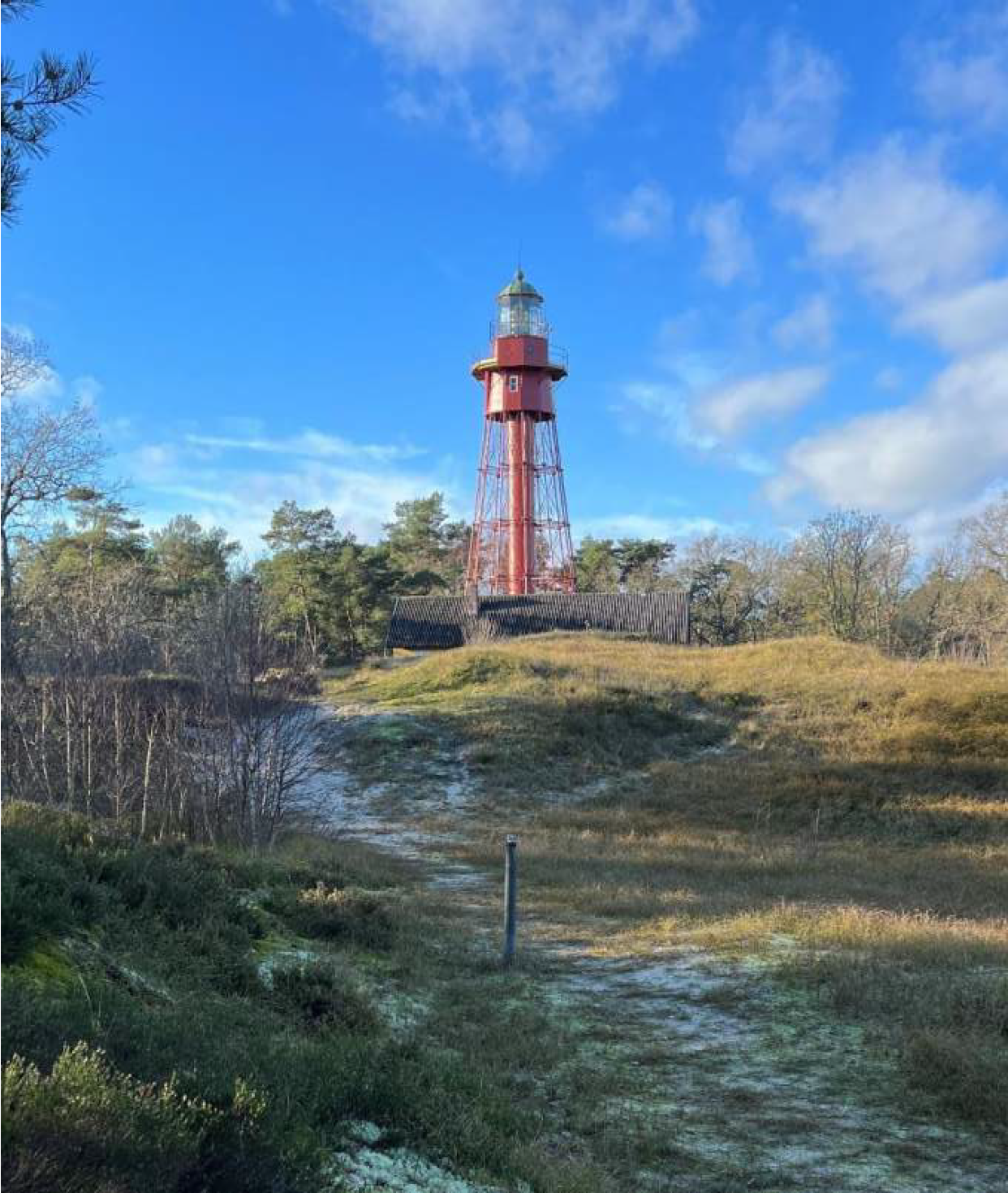Sandhammarens fyr
IALA Heritage Lighthouse of the Year 2025 Nominee
Location: SWEDEN Skåne, Ystad
Lighthouse Operator: Swedish Maritime Administration (SMA)

Lighthouse Description and History
(Text extracted from nomination form submitted by Swedish Maritime Administration (SMA), Sweden, 2025)
The huge expansion of international shipping and foreign trade from 1850 to 1870 made the state invest in a significant expansion of the lighthouse and pilotage system. Outside Sandhammaren there are hundreds of shipwrecks stranded on the treacherous sandbanks.
One of the main figures behind the significant expansion and technical improvements was the engineer Nils Gustaf von Heidenstam.
Heidenstam developed a lighter lighthouse structure made of iron trusses. In order to be able to erect the lighthouses on loose sand, large iron screws were drilled into the ground so that the lighthouse could be attached to these. The structure was easy to transport and dismantle and considerably cheaper to manufacture and erect than the old stone lighthouses.
In 1863 two lighthouses was built on the sandy beaches of Sandhammaren, 29 meters high with second-order lens devices. Next to the lighthouses they built quarters for the personnel and eventually a rescue station was moved here. The rescue station closed down 1945 but the one remaining light house still working.
Early Chronology
1859 The Swedish Parliament grants a grant of SEK 181,000 for two lighthouses at Sandhammaren.
1862 Two lighthouses were built.
1869 Both lighthouses were reinforced with additional crossbars, as they swayed in strong winds.
1869 The rapeseed oil lamps were replaced with kerosene lamps.
1891 The drum lens was replaced in the southern tower with a new rotating lens apparatus, which gives a flash every 5 seconds. The lens is driven by a clockwork with a weight, which weighed 140 kg. A drum for the weight was mounted outside the stairwell. The northern lighthouse was extinguished but was allowed to remain until 1904.
1893 A telephone was installed at the lighthouse site.
1893-1894 The fog siren with a motor-driven compressor was installed in a newly built engine house.
1894 A new residence was built for the lighthouse keeper.
1895 The lighthouse received a three-pound fog signal cannon, manufactured in 1812.
1898 An approximately 10 km long telephone line was installed between the lighthouse and the village of Borrby.
1902 The kerosene lamp was replaced with the first Lux light in Sweden.
1904 The northern tower was dismantled. In 1905, it was supplemented with two height sections and installed at the island of Pite-Rönnskär.
During 2023 and 2024, the remaining lighthouse was carefully restored and regained its former glory.
Reason For Nomination
(Text extracted from nomination form submitted by Swedish Maritime Administration (SMA), Sweden, 2025)
Intrinsic Heritage Interest of the Lighthouse
The remaining lighthouse was the first to be built with this type of light cast iron and wrought iron structure in Sweden. The structure could easily be moved in case the sand moved along the coast. The screw pillar foundation was also new to the country. Engineer Nils Gustaf von Heidenstam and engineer Gellerstedt had travelled abroad to get inspiration for solving the issue with having to build lighthouses in low lying areas of the coast where sandbanks moving inland and far out at sea.
The lighthouse was also one of the first to get a warning system for fog in Sweden. 1893-1894 a fog siren with motor-driven compressor was installed in a newly built engine house. It is easy to follow the traces of the different warning systems in the buildings as the technique evolved.
The lighthouse and the engine building is still in and have always been in working condition. However, it have had many uses during wartimes and during the cold war.
The lighthouse museum is located in the old engine house next door and has been updated during 2025 in collaboration with the Swedish Lighthouse society.
Next to the light house there is a rescue station from 1891 and it is also opened for the public as a museum.
Conservation
In 2023 and 2024 the Swedish Maritime Administration undertook a restoration of the tower. The towers main issue was rust on the supporting structure, around window/doors and balcony. Crevice corrosion was badly spread in the whole structure.
Since the quality of the iron varies the steel workers had a big challenge with welding.
The copper roof was leaking badly and the corrosion had bent the copper sheets and the cast iron structure underneath the copper roof and the brass structure holding the lanterns windows. The drainage through the lion heads (spygatt) was restored carefully and the copper roof had a few new copper sheets welded to the old.
The lighthouse exterior and interior was carefully sandblasted and painted with a combination of traditional linseed oil paint and modern alkyd (exterior).
The shades/hues of paint was based on the original layers found by the heritage specialist. Some areas was treated by conservation specialists. The old clockwork for the rotating lens was carefully cleaned and is still working.
After consideration an indoor office from the cold war period was not rebuilt, but was documented for the future.
Public Access and Education
The lighthouse is opened to the public during the summer months with attending guides telling the fascinating history of the area. The museum in the engine building was recently updated and highlights the lighthouse many uses through the years.
Other Reasons Why the Nominated Lighthouse Would Promote World Lighthouse Heritage
The Sandhammaren lighthouse is one of Swedish Maritime Administrations 38 listed heritage sites.
It is located in a nature reserve aiming to save sand and sea living species.
